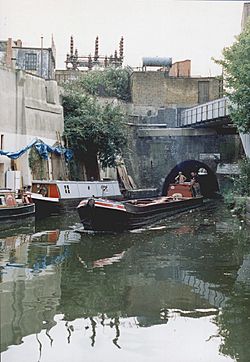Maida Hill Tunnel facts for kids
 |
|
| Eastern portal of the tunnel, August 1989 | |
| Overview | |
|---|---|
| Location | Maida Vale, St John's Wood, London |
| Coordinates | 51°31′30.57″N 0°10′32.74″W / 51.5251583°N 0.1757611°W |
| OS grid reference | TQ267823 |
| Status | Open |
| Waterway | Regent's Canal |
| Start | 51°31′28.29″N 0°10′37.38″W / 51.5245250°N 0.1770500°W |
| End | 51°31′33.13″N 0°10′27.25″W / 51.5258694°N 0.1742361°W |
| Operation | |
| Owner | Canal and River Trust |
| Technical | |
| Length | 272 yards (249 m) |
| Towpath | No |
The Maida Hill Tunnel is a canal tunnel located on the Regent's Canal in London, England. It is one of three tunnels on the Regent's Canal, with the others being Islington Tunnel and Eyre's Tunnel. This tunnel helps boats travel through parts of London where building a canal above ground was not possible.
Contents
Building the Maida Hill Tunnel
The idea for the Regent's Canal was approved by a special law in July 1812. The plans were first drawn up by James Morgan. He worked with a famous architect named John Nash. With Nash's help, Morgan became the main engineer for the new canal company.
Morgan was in charge of building the canal. However, he didn't have much experience with big engineering projects. So, the company asked for ideas for the locks and tunnels. A builder named Daniel Pritchard was chosen to construct the tunnels. He was known for building other long canal tunnels.
Why a Tunnel Was Needed
The first plans for the canal didn't include a tunnel at Maida Hill. But, people living in the area objected to the canal's path. This meant a tunnel became necessary. More objections also led to the shorter Eyre's Tunnel being built nearby.
Work on the tunnel started in 1812. It faced challenges when workers hit an underground spring. Water rushed in, causing injuries to the workers and delays. Despite these problems, both the Maida Hill and Eyre's Tunnels were finished by 1816. This allowed a part of the canal to open that same year.
The soil dug out from the tunnels was used to level land north of the canal. This land later became the third location for Lord's Cricket Ground. The canal had actually cut through part of the cricket field's previous location.
How Boats Traveled Through the Tunnel
The Maida Hill Tunnel was built without a towpath. This meant horses or people couldn't walk alongside the boats to pull them through. Instead, boats had to be 'legged' through the tunnel. This was a unique and difficult method.
'Legging' involved people lying on top of the boat. They would then use their feet to push against the tunnel walls or ceiling. This pushed the boat forward. It was a risky job, and there were reports of serious accidents during this time.
In 1951, the first motor trip boat, Jasons Trip, started using the tunnel. Later, in 1953, another boat called Evelyn also traveled through. It was pulled by a horse on one side of the tunnel and a tractor on the other. Through the tunnel itself, it was still moved by human power.
In the 1970s, a cafe was built at the west end of the tunnel. It's called Cafe Laville and sits on a concrete platform right above the tunnel's entrance.
The Canal's Journey Through London
The Maida Hill Tunnel is part of a long, level section of the Regent's Canal. This section is about 27 kilometers (17 miles) long.
East of the Tunnel
To the east of the tunnel are the Camden Locks. These are the first three of twelve locks that lower the canal by about 29 meters (96 feet). This descent leads to Limehouse Basin, which connects to the River Thames through Limehouse Lock.
After passing under a road bridge (the A5205), the canal makes a sharp turn. To the left, you can see the remains of Cumberland Basin. The canal then follows the northern edge of Regent's Park, where the famous London Zoo is located.
You'll then pass through a long, wooded area. The canal then goes past a housing area built where a large goods yard used to be. Next, you enter Eyre's Tunnel, which is also known as Lisson Grove Bridge. This leads directly into the eastern entrance of the Maida Hill Tunnel.
West of the Tunnel
The Maida Hill Tunnel runs underneath Aberdeen Place. Here, you can find the well-known Crocker's Folly Hotel. It's said to be named "Crocker's Folly" because it was built expecting a railway line that went to Marylebone instead.
After that, the tunnel goes under Edgware Road. It then emerges at its western entrance, with the Cafe Laville restaurant above it. The area between the tunnel and Little Venice is beautiful. It has many trees and grand old houses on both sides.
At Little Venice, the canal connects with the Paddington Arm. This leads to Paddington Basin. The main canal continues west towards Old Oak Common, where Eurostar trains are kept, and Wormwood Scrubs park and prison.
The canal through the Maida Hill Tunnel is wide enough for large boats. These boats can be up to 4.4 meters (14.5 feet) wide. The tunnel is about 0.6 kilometers (0.4 miles) from Paddington Junction.
The tunnel is only wide enough for one boat at a time. This means boats must wait if another boat is coming from the opposite direction. In 2016, the Canal & River Trust made it possible for non-motorized boats, like kayaks and canoes, to use the tunnel.

